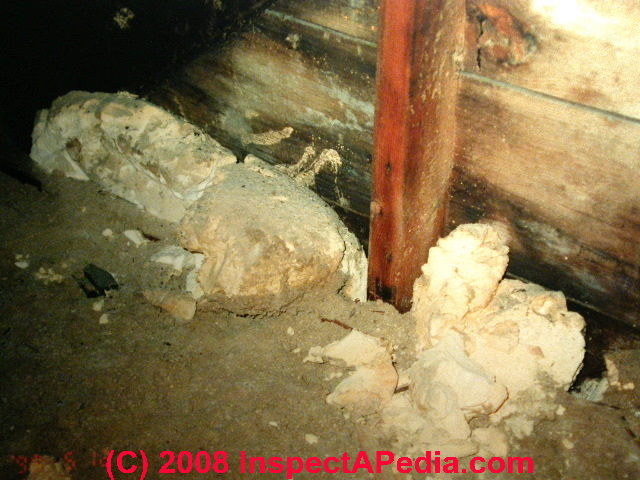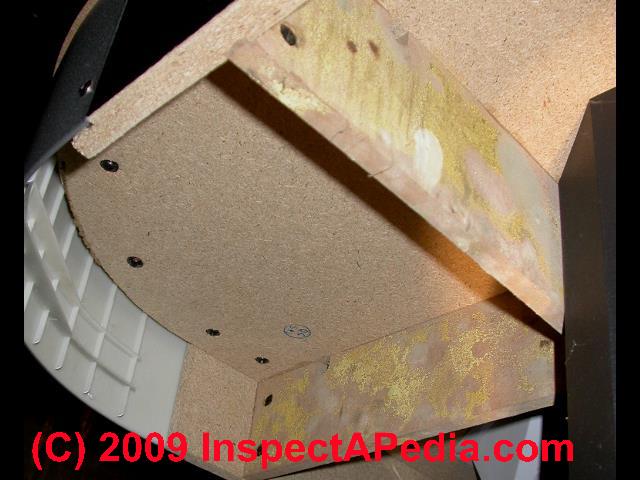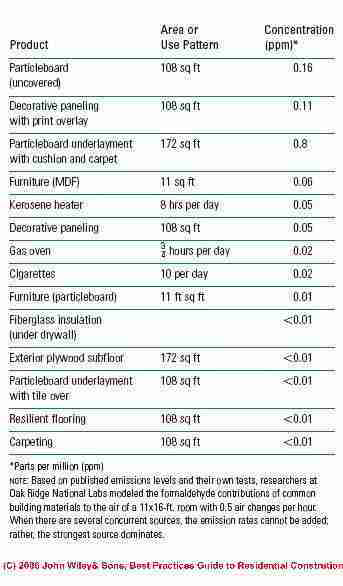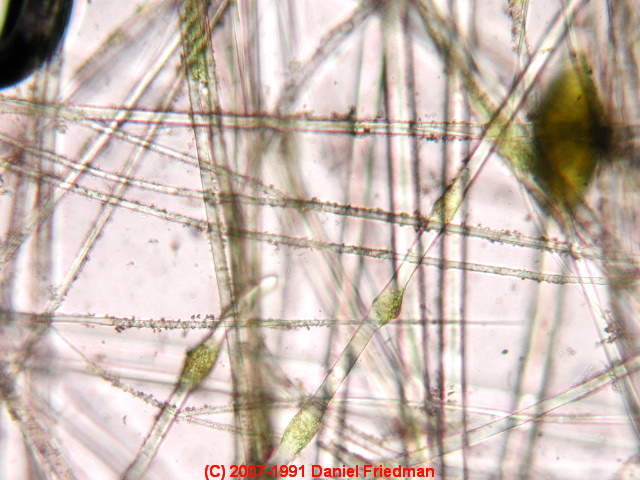 Sources of Formaldehyde Gas
Sources of Formaldehyde Gas
Formaldehyde Outgassing Hazards In Buildings
- POST a QUESTION or COMMENT about the sources of formaldehyde gas hazards, odors, or smells in buildings
Formaldehyde gas sources in buildings: what are the possible sources of formaldehyde off-gassing in and around buildings?
Page top photo: Urea formaldehyde foam insulation or UFFI, installed in the 1970s in a New York home, was in some instances a source of formaldehyde off gassing problems in buildings.
This article series describes the health risks of exposure to formaldehyde gas in air or water, and we describe the proper steps to remove formaldehyde gas and formaldehyde gas emitting building products in order to improve indoor air quality in homes, offices, other.
InspectAPedia tolerates no conflicts of interest. We have no relationship with advertisers, products, or services discussed at this website.
- Daniel Friedman, Publisher/Editor/Author - See WHO ARE WE?
Building Materials or Furnishing Products that Are Common Sources of Indoor Formaldehyde
 The list of all possible building products, furnishings, and contents that might be sources of formaldehyde would number in the thousands and at best is confusing since the formaldehyde gas emitting properties of different materials and products vary considerably.
The list of all possible building products, furnishings, and contents that might be sources of formaldehyde would number in the thousands and at best is confusing since the formaldehyde gas emitting properties of different materials and products vary considerably.
Beginning here we describe the principal categories of formaldehyde gas-emitting sources likely to be in buildings in order to help track down possible formaldehyde problem sources that might be addressed after it has been determined that there is a formaldehyde hazard in a particular structure.
Photo: some manufactured wood board products such as the particleboard (or MDF) used in this (moldy) countertop can be significant sources of formaldehyde in buildings.
Sources of Indoor Formaldehyde
- Building materials including some building insulation
- Cabinets & countertops (some) using particle board, wood composites, or pressed-wood products and possibly in construction adhesives, glues, coatings.
Currently (2022) pressed-wood products and in some cases laminated wood flooring products are the two most-common sources of formaldehyde offgassing in buildings. - Carpeting and carpet padding (some)
See CARPETING & INDOOR AIR QUALITY - Cigarette smoke
- Drywall & Drywall joint compound, "drywall mud", or drying agents and plasticizers used in some drywall products, both commercial and residential, have been reported to contain formaldeyde. See:
BUILDING MATERIAL EMISSIONS STUDY - CA [PDF] (2003) - California Integrated WasteManagement Board, For additional copies of this publication, contact: Integrated Waste Management Board Public Affairs Office, Publications Clearinghouse (MS–6) 1001 I Street P.O. Box 4025 Sacramento, CA 95812-4025 USA, www.ciwmb.ca.gov/Publications/ 1-800-CA-WASTE (California only) or (916) 341-6306 , Table 27, p. 127, reports on drywall products tested and found to exceed Section 01350 concentration limits for Formaldehyde.
CHINESE DRYWALL HAZARDS
Vallette, James FORMALDEHYDE ADDITIVES in US-MADE DRYWALL [PDF] (2010) - retrieved 2022/09/14, original source: the “Healthy Building Network” healthybuilding.net/blog/286-formaldehyde-additives-in-us-made-drywall - Emissions from un-vented, fuel burning appliances, like gas stoves or kerosene space heaters
- Fabrics (some) that are treated with chemicals to add a "permanent press" or wrinkle-resistant property can produce high levels of formaldehyde that has been described by some experts as producing a vinegar-like odor.
See VINEGAR ODOR SOURCES - Fertilizers and pesticides (EPA 2022)
- Fiberglass insulation (some resin binders) & other fiberglass products. Photo above: pale orange colored resin binder droplets on a single strand of fiberglass from building insulation, photographed in our forensic laboratory.
See FORMALDEHYDE in FIBERGLASS INSULATION
See FIBERGLASS REINFORCED PLASTICS - FORMALDEHYDE in LAMINATE FLOORING - reports that Lumber Liquidator's Chinese produced laminate flooring causing significant formaldehyde outgassing and possibly other laminate flooring products, particularly those produced using medium-density-fiberboard or MDF that appears as the core in many of these products.
- FORMALDEHYDE TESTS for FLOORING - discusses testing flooring for formaldehyde outgassing
- FORMALDEHYDE in LAMINATE FLOORING - Chinese produced laminate flooring formaldehyde outgassing
The largest source of formaldehyde in homes today is considered to be composite wood products, also called pressed wood products, made with urea-formaldehyde resins. - AIHA (May 2015) draft on file.
See FORMALDEHYDE TESTS for FLOORING
See FLOOR, WOOD ENGINEERED, LAMINATE, INSTALL - Glues and adhesives (some) using formaldehyde resins, for example resins used in the manufacture of composite wood products (i.e., hardwood plywood, particleboard and medium-density fiberboard) (US EPA 2022)
- Household products such as glues, permanent press fabrics, paints and coatings, lacquers and finishes, and paper products (US EPA 2022)
- Insulation materials (some) including some foam spray insulating products. See
- UREA FORMALDEHYDE FOAM INSULATION, UFFI - was UFFI a demonstrable health hazard? what to do about UFFI in buildings.
During the 1970s, formaldehyde was used in producing urea-formaldehyde foam insulation (UFFI), which was blown into the walls of many homes in the U.S. and Canada and later banned after elevated levels of formaldehyde were found in a small number of homes. Testing has since shown that, in most cases, any excess formaldehyde was released within a few days of installation.
Nonetheless, the material was removed from a large number of homes and banned for several years in the United States and permanently banned in Canada. - URETHANE FOAM DETERIORATION & OUTGASSING - rate of outgassing from polyurethane foam insulation
- UREA FORMALDEHYDE FOAM INSULATION, UFFI - was UFFI a demonstrable health hazard? what to do about UFFI in buildings.
- Paints or other coatings (some) and some other building finishes
- Particle board used in a variety of furniture, furnishings, or other home products, including those produced using medium-density-fiberboard or MDF
- Preservatives used in some medicines, cosmetics and other consumer products such as dishwashing liquids and fabric softeners; (EPA 2022)
- Subflooring using particle board or MDF
More information is at Formaldehyde Exposure in Homes: A Reference for State Officials to Use in Decision-making [PDF] from the U.S. CDC.
At FORMALDEHYDE HAZARDS Steve Bliss reports that the most significant source of formaldehyde in homes today is pressed wood products made with urea- formaldehyde resins. These include particle board, interior hardwood paneling, and medium-density fiberboard (MDF), which has the highest concentration of urea- formaldehyde of any pressed wood product.
Table 7-7, excerpted from FORMALDEHYDE HAZARDS, at left lists the Contributions of Formaldehyde to Room Air from various building materials and activities.
For a different point of view, and from a group with special interests in the formaldehyde issue, see "The Formaldehyde Fuss", published by the RV Trade association who brought in their own expert to rebut the health concerns from formaldehyde and to address public perception of formaldehyde risks in RVs and mobile homes such as in the FEMA trailers and other mobile homes - September 2007.
Formaldehyde-emitting building materials
 Shown earlier on this page and again at left is an example of mold-contaminated particleboard used as the structure for a kitchen countertop.
Shown earlier on this page and again at left is an example of mold-contaminated particleboard used as the structure for a kitchen countertop.
Pressed-wood products such as particle-board, medium density fiberboard (MDF), as well as plywood, oriented strand board (OSB), and hardwood plywood paneling are among the most likely sources of elevated levels of formaldehyde indoors.
These products tend to be significant formaldehyde sources - at least until their outgassing has diminished over time - because:
- They use urea-formaldehyde resins that release higher levels of formaldehyde than some alternatives
- They are widely used in large areas of newer buildings
- These materials tend to have a large surface area: building wall sheathing, roof sheathing, sub flooring, cabinet carcases, shelving
- Often one or both sides of some of these materials, such as cabinet components and subflooring are un-coated
In fact many sources including Health Canada explain that
Most formaldehyde in homes comes from building materials used in the home, especially pressed-wood products, such as particleboard, medium density fiberboard, and hardwood plywood panelling. Pressed-wood products that use adhesives containing urea-formaldehyde resins generally release more formaldehyde than those containing phenol-formaldehyde resins.
In general, these products will emit less and less formaldehyde over time. However, it can take weeks, months or even years to stop completely.
Formaldehyde levels are, therefore, generally higher in newly built or newly renovated homes. More formaldehyde is also released on hot and humid days, so levels are often higher in the summer. - "Formaldehyde in Indoor Air", Health Canada, retrieved 29 March 2015, original source: http://www.hc-sc.gc.ca/ewh-semt/pubs/air/formaldehyde/fact-info-eng.php
Formaldehyde-emitting furnishings & soft goods
Formaldehyde is used to add permanent press qualities to clothing and drapes and as the adhesive resin in some carpeting [and possibly in some carpet padding], fiberglass insulations, and (depending on where you live) in glass fiber or glass wool insulation.
You can see greenish-yellow binder resin in the photo-micrograph of fiberglass insulation just below.
Our microscopic photograph of fiberglass insulation (above) is discussed in more detail
at FIBERGLASS INSULATION IDENTIFICATION & PROPERTIES
Interior coatings as formaldehyde sources
Because formaldehyde is used as as a preservative in many paints and coatings these can produce significant off-gassing of formaldehyde (and other VOCs) especially when newly-applied.
Continuing a comment from Health Canada
Other sources of formaldehyde include ... some paints and adhesives, varnishes and floor finishes and permanent press fabrics. - op. cit.
Indoor Combustion as a Formaldehyde Source
Formaldehyde is also a product of combustion found in tobacco smoke and the fumes from gas stoves and other unvented combustion.
Formaldehyde Gas in Mobile Homes & Disaster Housing or FEMA Trailers
Before 1985 formaldehyde gas levels were particularly high in mobile homes because of the combination of use of large amounts of paneling, carpeting, and particleboard, and because of their comparatively small enclosed space.
Formaldehyde products that emit that gas in mobile homes were regulated (and generally reduced) beginning in 1985 when the HUD standard set a limit on particleboard emissions in mobile homes of 0.3 ppm and 0.2 ppm from plywood paneling (based on a standard "large-scale test chamber").
Formaldehyde was reported as a significant problem in FEMA-provided mobile homes or trailers that were provided to people who lost their homes during Hurricanes such as Hurricane Katrina or Hurricane Sandy. In 2012 NBC News reported a $42.6 million class-action lawsuit settlement against the manufacturers of FEMA trailers. Quoting from NBC News:
"More than six years after Gulf Coast victims of Hurricane Katrina began experiencing adverse health effects while living in travel trailers provided by the federal government for temporary housing, a federal judge in New Orleans has given his final approval to a $42.6 million settlement of a class-action lawsuit alleging that the units emitted hazardous levels of the toxic chemical formaldehyde. - Mike Brunker, David Friedman (photos), NBC News, "Class-action suit against FEMA trailer manufacturers settled for $42.6 million.
...
As msnbc.com (now NBCNews.com) first reported in July 2006, residents of the trailers began complaining of headaches, nosebleeds and breathing difficulty shortly after moving into the trailers, which were trucked to the Gulf Coast by the tens of thousands after Katrina and Rita devastated the area in rapid succession in 2005.
Air quality tests of 44 FEMA trailers in early 2006 conducted by the Sierra Club found formaldehyde concentrations as high as 0.34 parts per million – a level nearly equal to what a professional embalmer would be exposed to on the job, according to one study of the chemical’s workplace effects.
...
And government tests on hundreds of trailers in Louisiana and Mississippi announced in 2008 found formaldehyde levels that were, on average, about five times what people are exposed to in most modern homes." - NBC News, 28 Sept 2012, retrieved 5/8/15 original source: http://investigations.nbcnews.com/_news/2012/09/28/14140222-class-action-suit-against -fema-trailer-manufacturers-settled-for-426-million
References & Research on Formaldehyde Hazards in Disaster Housing & FEMA Trailers
- Babington, Charles. "FEMA slow to test toxicity of trailers." USA Today 21 (2007).
- Centers for Disease Control. "Final report on formaldehyde levels in FEMA-supplied travel trailers, park models, and mobile homes." Retrieved on December 28 (2008): 2008.
- DeVany, Mary C. "The Serious Public Health Issues Resulting from Formaldehyde Exposures Within FEMA Travel Trailers Issued to Hurricane Disaster Victims, and Recommended Action Items." (2007).
- Hampton, M. "Formaldehyde in FEMA Travel Trailers Making People Sick." (2006).
- Maddalena, Randy, Marion Russell, Douglas P. Sullivan, and Michael G. Apte. "Formaldehyde and other volatile organic chemical emissions in four FEMA temporary housing units." Environmental science & technology 43, no. 15 (2009): 5626-5632.
- Parthasarathy, Srinandini, Randy L. Maddalena, Marion L. Russell, and Michael G. Apte. "Effect of temperature and humidity on formaldehyde emissions in temporary housing units." Journal of the Air & Waste Management Association 61, no. 6 (2011): 689-695.
- Shehab, Nadine, Michael P. Anastario, and Lynn Lawry. "Access to care among displaced Mississippi residents in FEMA travel trailer parks two years after Katrina." Health Affairs 27, no. 5 (2008): w416-w429.
- see also FORMALDEHYDE GAS SOURCES & HAZARDS RESEARCH where we include PDF vesions of some of the citations above.
Urea Formaldehyde Outgassing Sources Continue in Use in Modern buildings
A California study of indoor air quality in recently built homes (3-5 years old) found a similar range: indoor concentration of formaldehyde ranged from 4 ppb to 120 ppb, with a median of 29 ppb. The outdoor formaldehyde concentrations ranged from < 1 ppb to 6.5 ppb with a median of 1.7 ppb. - (Offermann, 2009 seeReferences or Citations )
As New Zealand building investigator Paul Probett has pointed out (May 2010) that UFFI continues to be a concern as a formaldehyde outgassing source and that building moisture and formaldehyde outgassing appear to have an important relationship:
... We are becoming increasingly concerned here as [UFFI urea formaldehyde foam insulation] off gassing rates ( the company doing installs here uses USA sourced UF foam) do not seem to stabilize as quickly as some literature suggests. Since NIOSH and CDC ... [currently] class Urea Formaldehyde as a carcinogen, [see above] we have elevated concerns.
The other issue is that we are getting anecdotal evidence that when UFFI is wet it breaks down to airborne UF. In addition given your recent FEMA problem with class actions over UF release from emergency accommodation trailers used after Hurricane Katrina- the issue has a new lease of life.
We still use UF [Urea Formaldehyde] in large quantities in particle board here ( 106kg/m3 of UF and about 20kg/m2 of Toluene) and believe we are seeing off gassing of these products from wet ... OSB ... at levels high enough to suggest high risk to long term occupants.
In February 2008, in CDC RELEASES RESULTS of FORMALDEHYDE TESTS [PDF] 14 February 2008
In "FORMALDEHYDE HAARDS in HOMES: A Reference for State Officials to Use in Decision-making [PDF] the U.S. CDC, Department of Homeland Security, FEMA, and the US EPA reported on the past and current level of formaldehyde hazards in buildings.
For a different point of view, and from a group with special interests in the formaldehyde issue, see "The Formaldehyde Fuss", published by the RV Trade association who brought in their own expert to rebut the health concerns from formaldehyde and to address public perception of formaldehyde risks in RVs and mobile homes such as in the FEMA trailers and other mobile homes - September 2007.
InspectAPedia.com is an independent publisher of building, environmental, and forensic inspection, diagnosis, and repair information for the public - we have no business nor financial connection with any manufacturer or service provider discussed at our website.
Other Sources of Indoor Formaldehyde Gas & What Gets Rid of Formaldehyde
Other sources of indoor formaldehyde gas emission that continue to generate consumer complaints in some homes (though certainly not with all products) include formaldehyde outgassing from some carpet backings, carpet padding, glues, and fabrics.
Heat and humidity increase the level of emission of gases from building materials in general - therefore these may even be useful in speeding the outgassing process where that step is desirable.
Also see GAS EXPOSURE EFFECTS, TOXIC.
...
Reader Comments, Questions & Answers About The Article Above
Below you will find questions and answers previously posted on this page at its page bottom reader comment box.
Reader Q&A - also see RECOMMENDED ARTICLES & FAQs
Question: where to get affordable testing for formaldehyde
(Feb 12, 2012) Kim said:
I need some form of affordable testing for several different apartments including my own that can tell us if the formaldehyde levels are too high in this place.
We all have to sleep downstairs in our living rooms since living here. If we sleep upstairs we get headaches, feel very sick, throw up, ears ring very loudly, but symptoms do not happen if we sleep at some elses home, even company has become sick.
Our children are complaining of headaches, muscle aches, all of us ended up with asthma & broncitis, our vision is getting worse. We need help here in Pa.,
We have contacted the health dept. who said we need to contct the owners of our buildings. I did that, they refused saying there is nothing wrong with these places & we should feel grateful that they gave us such a lovely place to live and was told I am not aloud to talk to any of the other neighbors here or else ! So what are we to do ?
Reply:
Kim, you can find testing experts through your local health department, from the directory we list At the ARTICLE INDEX at the end of this article , and from local directory listings.
You'll want to discuss your needs and finances with possible consultants you'd hire.
Watch out for superficial tests that are not diagnostic or not prescriptive - you can spend a lot of money (and others make a nice profit) without ever having information that actually gives you an accurate risk assessment, assures that you are focusing on the most important hazards in your home, and without telling you what actions are needed.
Question: report of formaldehyde outgassing from cabinets - how to speed the clean-up or clear-up of formaldehyde outgassing
My new cabinet's were off gassing .24 .27 .29 I kept coughing and couldn't stop went to the Drs now using inhaler - (July 26, 2014) PCantelli@cfl.rr.co
I have new paneling in my basement and the smell is giving me asthma attacks. I also have parrots. Will the smell eventually lessen? (Sept 21, 2014) Anonymous
Reply:
Anon and PCantelli:
Normally yes for most products outgassing diminishes substantially over time.
Watch out: however there are some formaldehyde outgassing products that continue to release detectable formaldehyde for a longer period, even months or years.
In our OINION in the first group are carpets and carpet paddings, in the second group, harder materials such as flooring and particleboard, particularly depending on where, how and by what company they were m ade.
You can speed the process of off gassing and reduction in the formaldehyde level in your building for most products by using a combination of heat and ventilation with fresh air.
...
Continue reading at FORMALDEHYDE GAS HAZARD REDUCTION where we discuss how to remove, avoid, or eliminate indoor formaldehyde gas hazards or select a topic from the closely-related articles below, or see the complete ARTICLE INDEX.
Or see these
Recommended Articles
- FORMALDEHYDE HAZARDS - home
- GAS DETECTION INSTRUMENTS - home
- GAS EXPOSURE SCREENING TEST
- INDOOR AIR QUALITY IMPROVEMENT GUIDE - home
- ODORS GASES SMELLS, DIAGNOSIS & CURE - home
- UREA FORMALDEHYDE FOAM INSULATION, UFFI
Suggested citation for this web page
FORMALDEHYDE GAS SOURCES in BUILDINGS at InspectApedia.com - online encyclopedia of building & environmental inspection, testing, diagnosis, repair, & problem prevention advice.
Or see this
INDEX to RELATED ARTICLES: ARTICLE INDEX to GAS HAZARDS in BUILDINGS
Or use the SEARCH BOX found below to Ask a Question or Search InspectApedia
Ask a Question or Search InspectApedia
Try the search box just below, or if you prefer, post a question or comment in the Comments box below and we will respond promptly.
Search the InspectApedia website
Note: appearance of your Comment below may be delayed: if your comment contains an image, photograph, web link, or text that looks to the software as if it might be a web link, your posting will appear after it has been approved by a moderator. Apologies for the delay.
Only one image can be added per comment but you can post as many comments, and therefore images, as you like.
You will not receive a notification when a response to your question has been posted.
Please bookmark this page to make it easy for you to check back for our response.
IF above you see "Comment Form is loading comments..." then COMMENT BOX - countable.ca / bawkbox.com IS NOT WORKING.
In any case you are welcome to send an email directly to us at InspectApedia.com at editor@inspectApedia.com
We'll reply to you directly. Please help us help you by noting, in your email, the URL of the InspectApedia page where you wanted to comment.
Citations & References
In addition to any citations in the article above, a full list is available on request.
- See references cited at FORMALDEHYDE GAS SOURCES & HAZARDS RESEARCH
- Best Practices Guide to Residential Construction, by Steven Bliss. John Wiley & Sons, 2006. ISBN-10: 0471648361, ISBN-13: 978-0471648369, Hardcover: 320 pages, available from Amazon.com and also Wiley.com. See our book review of this publication
- In addition to citations & references found in this article, see the research citations given at the end of the related articles found at our suggested
CONTINUE READING or RECOMMENDED ARTICLES.
- Carson, Dunlop & Associates Ltd., 120 Carlton Street Suite 407, Toronto ON M5A 4K2. Tel: (416) 964-9415 1-800-268-7070 Email: info@carsondunlop.com. Alan Carson is a past president of ASHI, the American Society of Home Inspectors.
Thanks to Alan Carson and Bob Dunlop, for permission for InspectAPedia to use text excerpts from The HOME REFERENCE BOOK - the Encyclopedia of Homes and to use illustrations from The ILLUSTRATED HOME .
Carson Dunlop Associates provides extensive home inspection education and report writing material. In gratitude we provide links to tsome Carson Dunlop Associates products and services.




